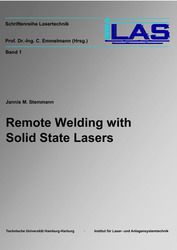| Departments | |
|---|---|
| Book Series (96) |
1378
|
| Nachhaltigkeit |
3
|
| Gesundheitswesen |
1
|
| Humanities |
2364
|
| Natural Sciences |
5406
|
| Engineering |
1793
|
| Engineering | 292 |
| Mechanical and process engineering | 862 |
| Electrical engineering | 686 |
| Mining and metallurgy | 30 |
| Architecture and civil engineering | 75 |
| Common |
98
|
|
Leitlinien Unfallchirurgie
5. Auflage bestellen |
|
Advanced Search
Remote Welding with Solid State Lasers (Volume 1) (English shop)
Jannis Martin Stemmann (Author)Preview
Table of Contents, Datei (41 KB)
Extract, Datei (230 KB)
As a young technology on the verge of application in series production, literature on remote welding with solid state lasers is still rare to find. The thesis at hand probably is the first encompassing text on this subject. Therefore a broad introduction into remote welding setups is given, including those with CO2 lasers for which more experience exists. Robot based CO2 laser systems suffer from a cumbersome beam delivery, which is the reason why gantry machine beds are preferred. This restriction does not exist for YAG lasers, and as a consequence more flexible systems assisted by standard articulated robots can be devised. Furthermore, an overview on remote welding process characteristics is covered. The seminal difference to conventional laser welding (or any other joining technology) is the remarkably low amount of auxiliary processing times resulting from high speed focus displacement. This is achieved by means of rotating optic units or components, favourably supported by long working distances and angular beam incidence. Process development differs in only few aspects from common laser welding, for instance shielding gas supply. Following this delineation of basic remote welding principles, suggestions on system design are given. After an extract of optics fundamentals, lens design for a welding head with large operating range is proposed. As the prevailing optic units for remote welding with solid state lasers are galvanometric scanners, their buildup is discussed, as well as postobjective scanners with alternate optomechanical designs. System development incorporates other aspects besides optic units, and thus some ideas on production oriented workpiece design are covered. Moreover, the chapter includes layouts of two laboratory clamping devices which enable fast process development and welding of thin steel foils. One of the main criteria of a manufacturing system is its precision, and a final section in this part is dedicated to a repeatability measurement setup, which was tried for three different laser welding systems. Positioning errors of the manipulator were found to be the major influence on system repeatability.
| ISBN-13 (Printausgabe) | 386537820X |
| ISBN-13 (Hard Copy) | 9783865378200 |
| ISBN-13 (eBook) | 9783736918207 |
| Language | English |
| Page Number | 184 |
| Edition | 1 |
| Book Series | Schriftenreihe Lasertechnik |
| Volume | 1 |
| Publication Place | Göttingen |
| Place of Dissertation | Hamburg-Harburg |
| Publication Date | 2006-03-01 |
| General Categorization | Dissertation |
| Departments |
Mechanical and process engineering
|








